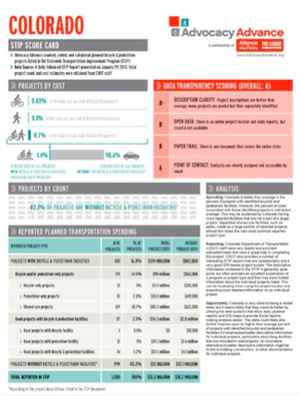OpenGov Voices: More transparent data is needed on bicycle and pedestrian spending

Each year, billions of federal tax dollars are given to state Departments of Transportation (DOTs) to be spent according to priorities developed by state DOTs and local entities, primarily Metropolitan Planning Organizations (MPOs). For fiscal year 2014, $37 billion was apportioned to the states. At least every four years, states must publish a list of projects that will be funded by federal tax dollars. This list of projects is known as a Statewide Transportation Improvement Program (STIP).
In Lifting the Veil on Bicycle and Pedestrian Spending — a recent report by Advocacy Advance (a dynamic partnership of the Alliance for Biking & Walking and the League of American Bicyclists to boost local and state bicycle and pedestrian advocacy efforts), we look at STIP documents to better understand planned investments in facilities for people who bike and walk – and just as importantly why we don’t know more about these planned investments. The Sunlight Foundation’s Open Data Principles and Guidelines were extremely helpful during the writing of this report and are great resources as advocates and agency staff work to improve this important data.
Minimal project descriptions
Although the STIP document is published midway through the federal transportation planning process, the average project reported in a STIP was described with a sentence or two. This lack of information, combined with the widespread use of codes and terms of art, undermine the ability of the public to understand planned projects. Without a strong understanding of the pipeline of projects in these documents, it is difficult to assess whether stated priorities and policies are reflected in plans. Several states were able to provide additional information upon request.

“Statewide” documents are often not statewide
The STIP is a product of collaboration between state DOTs and other entities within the state that make transportation decisions the most important of which are MPOs. However, only 29 states provided statewide documents that included information from all MPOs within the state and in several of those states MPOs used a different reporting format. This lack of coordination makes an already difficult to understand document more complicated. It was also more likely to lead to some documents provided to not be searchable. Several states were able to provide coordinated statewide data upon request.
Default is not open
During the course of research for the report, we contacted many state DOTs and MPOs to see if better data was available. While 12 states provided a spreadsheet of all or part of their STIP publicly, another 20 were able to provide one upon request. This shows that there is a latent ability to provide more accessible data, but that state DOTs do not provide this better data as a way of doing business. Project lists in spreadsheet format are important because they enable easy searching, sorting and analyzing of the information provided.
It is not uncommon for state DOTs to be able to provide many sorts of better data upon request — but the request must be made, sometimes with lengthy follow-up and at times without a clear place to make a request.
Moving forward
Fortunately, there are some promising signs that better STIP data and therefore a better understanding of how our federal tax dollars will be spent on transportation projects, is in the future:
- Several state DOTs have initiatives to coordinate long-term and short-term planning processes in order to provide more information. Most promising is the work of the Massachusetts Department of Transportation’s Highway Division to provide an impressively comprehensive project information database that includes information on subjects as diverse as contracts and design choices.
- 18 state DOTs and many MPOs have interactive maps or searchable online databases that provide more accessible ways to interact with the data contained in the STIP. The Oregon Department of Transportation’s Project Tracking tool and the Nashville Area MPO’s Interactive TIP Database are two good examples of innovative tools with visual components that provide more access to STIP-related data.
Although federal law requires state DOTs and MPOs to produce STIP documents that lay out projects that will be paid for with federal tax dollars, current reporting practices make these documents unwieldy and undermine their ability to provide effective oversight. Lifting the Veil on Bicycle and Pedestrian Spending provides an assessment of the states based upon 10 reporting-related criteria, highlights current best practices and makes recommendations on providing comprehensive, searchable and sortable information in the future.
Ken McLeod is the Legal Specialist at the League of American Bicyclists and a member of the Advocacy Advance partnership between the League and the Alliance for Biking & Walking. He provides technical support to advocates attempting to pass state legislation and conducts research to ensure that Advocacy Advance has the best possible understanding of federal transportation programs. Ken joined the League in 2012 after graduating from William & Mary School of Law and he is a licensed attorney in the state of Virginia. You can reach him at ken@bikeleague.org
Interested in writing a guest blog for Sunlight? Email us at guestblog@sunlightfoundation.com

